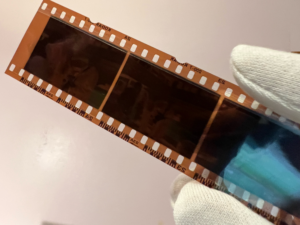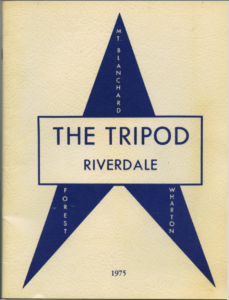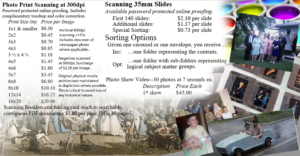Slides and Photos to CD
35mm Slides, Filmstrips, and Photos

Featuring online password-protected previewing and social media sharing.
Do you remember sitting with your family as a youngster looking over all of the family photos and slides? Have you looked at those slides in the last twenty years? Can you imagine the joy your own children would have and how excited they would be to be able to view them?
Hardware-Based Dust and Scratch Removal with High Dynamic Range
All slide and film scans include hardware-based dust and scratch removal using infrared technology. Anyone who has scanned photos (and especially slides) knows about those pesky speckles that always appear on a scanned image. It looks like someone sprinkled a salt shaker over the photo. One can go to great lengths cleaning the glass, dusting the photo, wear lint-free photographer’s gloves and still the speckles materialize as if out of nowhere. With infrared scanning of slides and films, an actual map is created that the software uses to precisely null out the lint and dust. All film and slide scans done at W. Cardone Productions include this process.
MultiScan To Improve Dynamic Range
We also offer a complimentary MultiScan upgrade to improve a scanned image’s dynamic range. It is a major challenge for video and all of the digital domain to match the enviable dynamic range of even 1950 vintage Kodachrome film.
Film Color Dyes Fade at Different Rates
Certainly, the most popular film used for slides was Kodachrome. But many slides were also taken using Ektachrome. Unlike Kodachrome, Ektachrome dyes fade at different rates over decades so slides only thirty years old will often show a distinct pinkish color cast. A trained professional can easily correct this in PhotoShop but results are greatly improved and time saved if the correction is accomplished as a part of the original scan. This hardware-based correction is included with all scans that we do.
Attention To Favorable Color Print Rotation
We recognize the disappointment clients have if their color print scan duplications show prints that are rotated 90 or 180 degrees from their original profiles. Understand that the duplication process involves placing several prints on a scanning glass at a time. If done in a random fashion without regard for imaging profiles, there would be many, many image duplications that are upside down, facing to the left, and otherwise. At W. Cardone Productions, we pay attention to these things making sure that they are rare to non-existent.
At W. Cardone productions we make every effort to make sure that the duplications you receive are good to look at out of the box.
Film Negatives 
In the old days of mom & pops home photography, few ever noticed or paid much attention to the negatives that came with their color prints from the processing lab. People would go to the drug store to buy their film, load it into their cameras, shoot photographs, rewind and remove the film from the camera and send it off to a processing lab to be developed and printed. What came back from the processing lab were beautiful color prints of the photographs shot. But many wondered what those orangish filmish deals were that came in the same envelope. This was the actual film that came from the drugstore. Negatives were important for mom & pops to retain in case they wanted duplicates of any of the photos equal in quality to those in the same envelope. The only catch was that you better not touch your negatives. They were (are) extremely fragile picking up scratches by almost your breathing on them but certainly picking up your very bold fingerprints on the film.
The importance of negatives today with your legacy media is that there is significant resolution over and above what is on the color prints. A 4×6″ color print in your library can easily be made into a brilliant 8×10″ that rivals the quality of the 4×6″ print. But the catch is if the negatives have never been touched. If anybody has ever handled these negatives without photographer’s gloves, then the print may be more useful than the negative. Prints are rugged, designed to take abuse and are resistant to fingerprints.
Booklets and Cardstock to PDF and Flipbook
School yearbooks, wedding program brochures, or other general advertising media, up to 10 x 16 inches, may be duplicated to a PDF book format for a nominal fee. The PDF media is delivered in a book-like form with contiguous pages.
For an amazingly low additional fee, the media may be delivered in a flipbook format as an HTML format or executable. A flipbook pages turn much as you would turn a magazine’s pages. This includes a sound of a page being flipped.
No special instructions on preparing your slides and prints.
Are your family heirloom memories stored in carousel trays, shoe boxes, and maybe zip-lock baggies? You may bring them to us as they are. However, it will be to your benefit to organize them for this will enable you (and your heirs) to easily link physical media with the digital representation that we give you. And rest assured…whatever organization you have your media in when you deliver it to us, it will have the SAME organization when it is returned to you (see below). But just as importantly, the digital organization you receive from us will mirror the physical organization.
Your Slides Return to You as You Gave Them to Us
When we process your slides we will make every effort to maintain an organization that may exist with your media. Duplicating your slides to the digital domain is only half the job. We are talking about legacy memories captured into still images. Without the story behind the image, the image is likely to become a forgotten legacy. Losing the ability to conveniently link the digital image with its physical source greatly reduces the actual memories and historical information that can be preserved and passed to future generations. For this reason, we make every effort to return your slides to you organized the way you gave them to us. The computer file and folder set we create for you, holding the digital representations of your slides, will have some manner of organization to it facilitating relative ease in linking the digital image with the physical slide it came from. You will always be able to refer to the original to obtain clues such as short handwritten notes concerning the nature of the photo.
“But I can just scan my slides myself.”
The consumer can pick up scanning equipment at various office supply retail outlets for from $39.00 to five or six hundred dollars and get fair results which may be good enough for the given application. If operating on a tight budget you might consider doing your own scans and then having us redo your entire library, group by group. We will then put watermarked low-resolution proofs up on a password-protected website photo gallery for your personal evaluation and sharing with friends and family. You may then decide which ones, if any, to accept.
Think about it…you buy some equipment and scan your entire library of slides and photos. When finished you sell that equipment on eBay. You then take a good size sample (a few hundred slides or prints) from your legacy photo library to us for duplication to digital. Watermarked proofs from that group are put up on a password-protected photo gallery on the web for you to decide which ones (if any) are significantly better than what you did yourself. Maybe you end up deciding that for your purposes, what you did yourself was good enough and choose not to accept any of our work taking your original media back into your possession.
Summary of Important Tasks We Bring to the Table
- Dust & scratches greatly reduced or eliminated
- High dynamic range with standard scan
- MultiScan option to improve dynamic range yet more
- Ektachrome’s pinkish color cast from age virtually neutralized
- Hardware is profiled to the type of film being scanned
- Online proofing allows you to accept or reject on an individual basis.
- Every effort is made to return your media to you in the form it was given to us
- Product is packaged professionally commensurate with its being a family heirloom
- Service you can depend on. See our 5-star, nuclear-powered, online reviews at maps.google.com.
Please call for additional details. If you choose to use a credit card we use wireless technology at your door for maximum security.

Slides and Photo Scanning
Slides
A 35mm slide is a specially mounted individual transparency placed inside a cardboard or plastic shell, intended for projection onto a screen using a slide projector.
Photographic Prints
Monochromatic, hand-painted, black and white or color.
